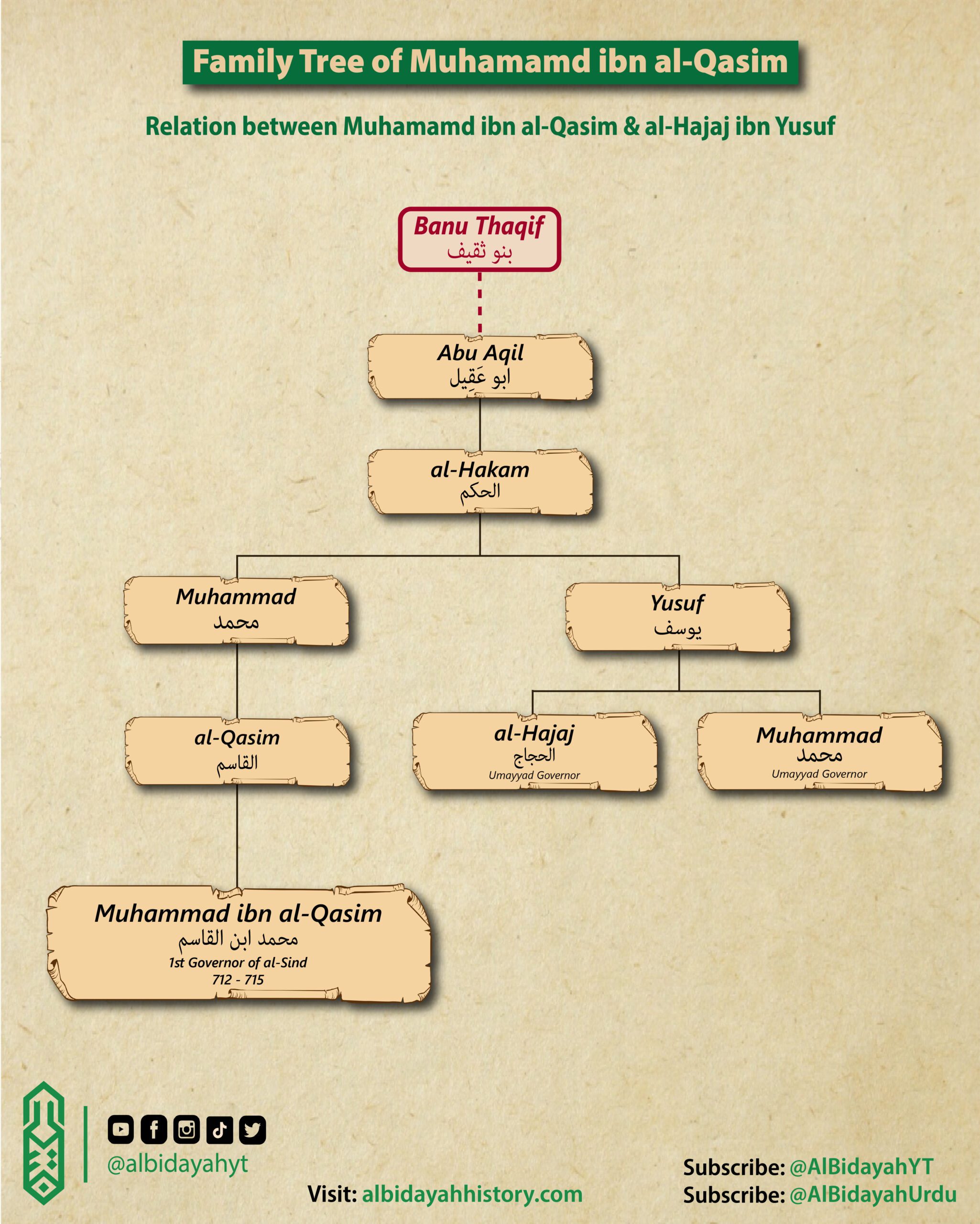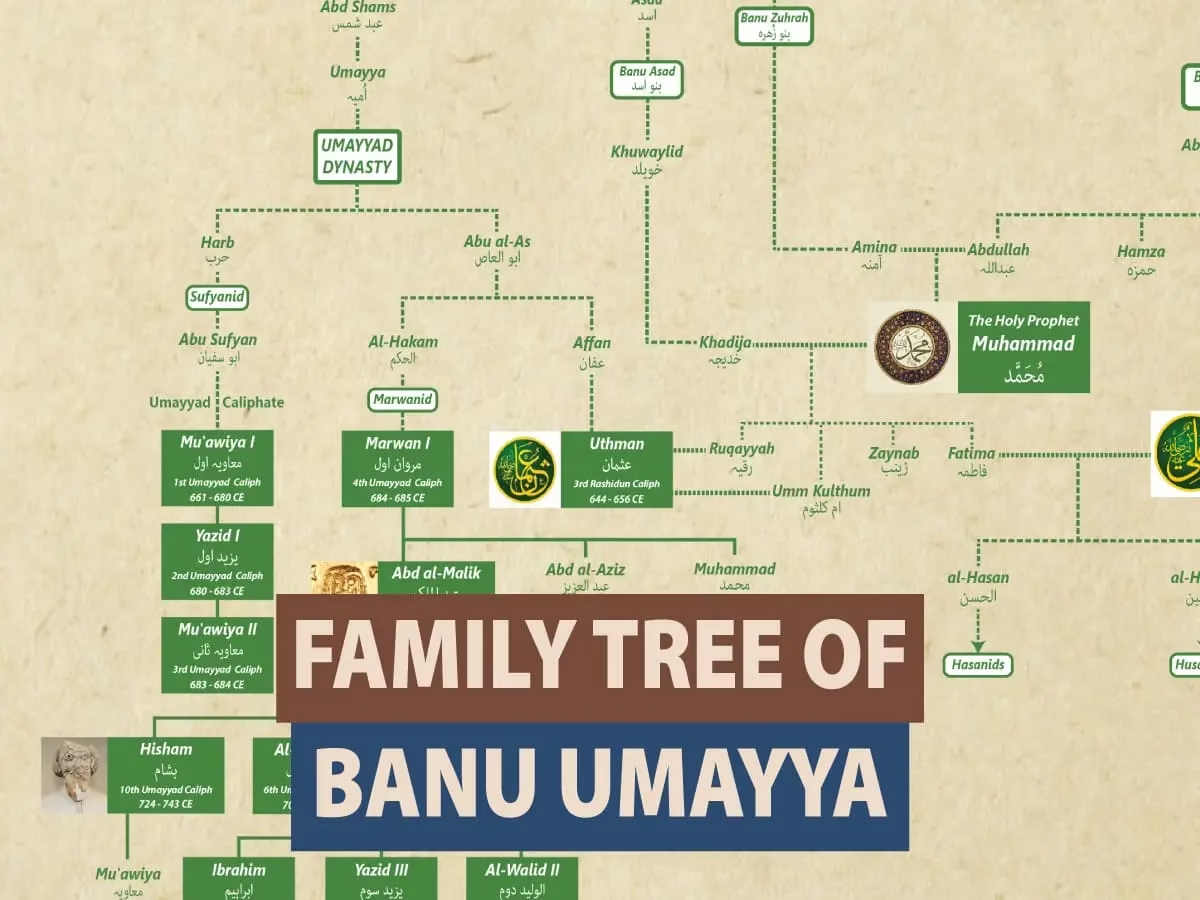The Muhammad bin Qasim family tree reveals the historical connection between him and the Umayyad governor, al-Hajjaj ibn Yusuf, through the Banu Thaqif tribe. Both figures played pivotal roles in Islamic history, with Muhammad ibn al-Qasim being the first governor of Sindh, known for his conquest of the region in 712 CE, and al-Hajjaj ibn Yusuf being a powerful Umayyad official responsible for numerous military and administrative reforms.

See Also: Banu Umayya Family Tree: Quraysh to Marwan II
Muhammad bin Qasim
Muhammad bin Qasim is remembered as a remarkable figure in Islamic history, known for his conquest of Sindh and the establishment of Muslim rule in the Indian subcontinent. His noble lineage played a crucial role in shaping his character and leadership.
Belonging to the Banu Thaqif tribe, his family had a strong influence in Arabian society. This lineage contributed to his military prowess, strategic mindset, and administrative skills. His conquest of Sindh in 711 CE under the Umayyad Caliphate marked the beginning of Islam’s presence in the region, leaving a lasting impact on South Asian history.
Banu Thaqif: Muhammad bin Qasim’s Ancestral Roots
The Banu Thaqif tribe, based in Ta’if, was one of the most influential clans of the Arabian Peninsula during the early Islamic era. Known for their bravery and intellect, the Banu Thaqif played a significant role in the administration and military campaigns of the Umayyad Caliphate.
Muhammad bin Qasim’s lineage is rooted in this prestigious tribe, connecting him to a legacy of distinguished leaders and warriors. His ancestry not only shaped his leadership and strategic skills but also influenced his role as a key figure in the expansion of Islam into the Indian subcontinent.
Key Figures in Muhammad bin Qasim’s Family Tree
Abu Aqil
At the root of Muhammad bin Qasim’s family tree lies Abu Aqil, a revered figure in the Banu Thaqif clan. As the patriarch, Abu Aqil’s legacy extends through his sons, whose contributions to the Umayyad administration were instrumental in consolidating the caliphate’s power.
Al-Hakam bin Abu Aqil
Al-Hakam, one of Abu Aqil’s sons, was a key figure in the lineage of Muhammad bin Qasim. Known for his integrity and leadership qualities, Al-Hakam’s influence paved the way for his descendants to assume critical roles in governance and military affairs.
Yusuf bin Abu Aqil
Another pivotal figure in the family tree is Yusuf bin Abu Aqil, the brother of Al-Hakam. His lineage includes the renowned Al-Hajjaj bin Yusuf, a dominant political and military leader of the Umayyad Caliphate. Al-Hajjaj’s strategic vision and administrative prowess were crucial in shaping the early Islamic empire.
Al-Hajjaj bin Yusuf
Al-Hajjaj bin Yusuf, Muhammad bin Qasim’s uncle, holds a distinguished place in Islamic history. Serving as the governor of Iraq under the Umayyad Caliphate, Al-Hajjaj was instrumental in appointing Muhammad bin Qasim to lead the campaign in Sindh. His mentorship and unwavering support were pivotal in Muhammad bin Qasim’s rise to prominence.
Muhammad bin Yusuf
Muḥammad bin Yusuf was a governor of the Umayyad Caliphate in the early 8th century. The brother of the governor of Iraq, al-Hajjaj bin Yusuf, Muhammad served under his brother as deputy governor for Fars. He is credited as the founder of the city of Shiraz, which became the capital of Fars, in 693.
He later served as governor for the Yemen. He died in the latter office in 714/5. His daughter Umm al-Hajjaj married caliph Yazid II (r. 620–624), and their son, al-Walid II (r. 743–744), ruled as the eleventh Umayyad caliph.
Al-Qasim bin Muhammad
Al-Qasim, the father of Muhammad bin Qasim, was a respected member of the Banu Thaqif tribe. Although less is recorded about his personal achievements, his upbringing and guidance laid the foundation for his son’s extraordinary accomplishments.
Connections Within the Family Tree
The family tree of Muhammad bin Qasim reveals strong ties between influential figures of the Umayyad era.
- Muhammad bin Qasim and Al-Hajjaj bin Yusuf: The mentorship and guidance of Al-Hajjaj played a crucial role in Muhammad bin Qasim’s success. Al-Hajjaj’s vision and strategic planning provided the necessary support for Muhammad bin Qasim’s campaign in Sindh.
- The Influence of Al-Hakam and Yusuf bin Abu Aqil: These two brothers—the uncles of Al-Hajjaj—established a legacy of leadership and service, which was carried forward by their descendants.
See Also: Seljuk Dynasty Family Tree



